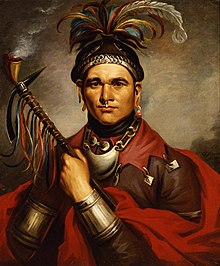Cornplanter | |
|---|---|
| Gaiänt'wakê, Kaintwakon | |
 Chief Cornplanter, portrait by Frederick Bartoli, 1796 | |
| Seneca leader | |
| Succeeded by | Edward Cornplanter |
| Personal details | |
| Born | c. 1752 Canawaugus (now part of Caledonia, Livingston, New York |
| Died | February 18, 1836 Cornplanter Tract, Warren, Pennsylvania |
| Resting place | Elk Township, Warren County, Pennsylvania |
| Relations | Handsome Lake (half-brother) Guyasutha (uncle). Chainbreaker (nephew) |
| Children | Henry O'Bail, Charles O'Bail, Polly O'Bail, William O'Bail, Esther O'Bail, Ja-wa-a-joh |
| Parent(s) | Gah-hon-no-neh (Seneca), Johannes Abeel (Dutch) |
| Known for | War chief of the Seneca during the American Revolutionary War |
| Nickname(s) | John Abeel, John O'Bail, John O'Beale |
John Abeel III (c. 1752–February 18, 1836)[1] known as Gaiänt'wakê (Gyantwachia – "the planter") or Kaiiontwa'kon (Kaintwakon – "By What One Plants") in the Seneca language and thus generally known as Cornplanter, was a Dutch-Seneca chief warrior and diplomat of the Seneca people. As a war chief, Cornplanter fought in the American Revolutionary War on the side of the British. After the war Cornplanter led negotiations with the United States and was a signatory of the Treaty of Fort Stanwix (1784), the Treaty of Canandaigua (1794), and other treaties. He helped ensure Seneca neutrality during the Northwest Indian War.
In the postwar years, Cornplanter endeavoured to learn more about Euro-American culture and invited Quakers to establish schools in Seneca territory. After the War of 1812 he became disillusioned by his people's poor reaction to Euro-American society. He had the schools closed and embraced his half-brother Handsome Lake's movement to return to traditional Seneca ways and religion.
The United States government granted him about 1500 acres of former Seneca territory in Pennsylvania in 1796 for "him and his heirs forever," which became known as the Cornplanter Tract. The federal government, however, started construction of the Kinzua Dam on the Allegany River in 1960. When the dam was completed the Cornplanter Tract was flooded and most of the few remaining residents moved to the Allegany Reservation of the federally recognized Seneca Nation of New York. Before flooding occurred the remains of Cornplanter, his descendants, and an 1866 monument to him were relocated.
- ^ Abler, Thomas S. (2007). Cornplanter: Chief Warrior of the Allegany Senecas. Syracuse, New York: Syracuse University Press. ISBN 9780815631149.